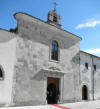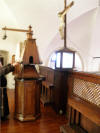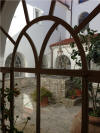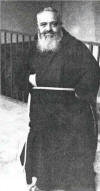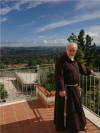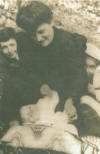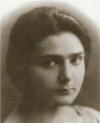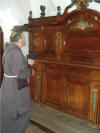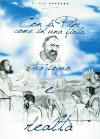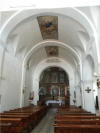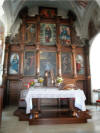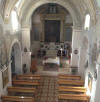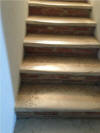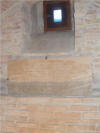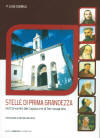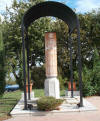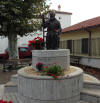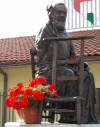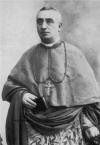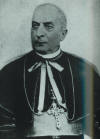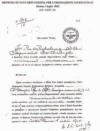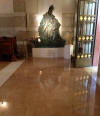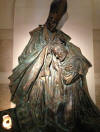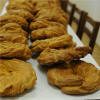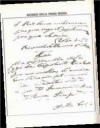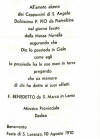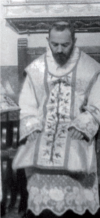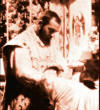2
Novice in Morcone, student, priest.
Summary:
Novice in Morcone, the Capuchin habit, life in the convent, padre
Tommaso, daily routine, temporary vows. Sant’Elia a Pianisi, enormous
dog, Giovanna Rizzani, missionary request. Campobasso. San Marco la
Catola. Sant’Elia a Pianisi, big tree, perpetual vows. Serracapriola. Montefusco,
Aunt Daria. Pietrelcina. Gesualdo. Minor
Orders. too much salt as deacon, age dispensation,
ordination to priesthood, prayer card: PERFECT VICTIM; celebration.
Novitiate in Morcone
The mountainside village of Morcone.
Map of the area.
On January 6, 1903, Francesco Forgione left home for Morcone, to begin the novitiate in the Capuchin Order. After the Mass of the Epiphany he went home to say goodbye to his parents, brother, sisters, relatives and neighbors.[1]
Leaving his world was very hard for Francesco: “It was a very painful,
excruciating, agonizing detachment.”[2]
His mom gave him a Rosary (still preserved) and said: "My son, Saint
Francis has called you, and you must go. Pray many Rosaries!"[3]
[4]
The trip from Pietrelcina to Morcone was by donkey and train. Two other aspiring novices, Vincenzo Masone and Antonio
Bonavita, traveled with Francesco. The three were accompanied by the priest Nicola Caruso and the
teacher Caccavo.[5]
Fra’ Camillo
When Francesco knocked, the door to the convent was opened by Fra’
Camillo, by coincidence the friar who had inspired him to become
a Capuchin. Fra’ Camillo said: “Bravo, bravo Franci'. You have been
faithful to the promise and to the call of St. Francis.”[6]
[7]
Francesco was assigned room #18, in the hallway leading to the choir;
later he went to #28, in the seminarians' hallway.[8]
The three were greeted by a committee of friars who did the first
screening. Francesco and Vincenzo were approved. Antonio was not yet 15,
so he had to return to Pietrelcina.[9]
Taking the habit
Padre Pio with Padre Anastasio da Roio and other friars, in later years.
Page of the registry of the convent, documenting brother Pio's vestition.
On January 22, 1903, at age 15, after two weeks of initiation, Francesco
and three other novices took the Capuchin habit, received the tonsure,
and changed their names.
Francesco Forgione became Brother
Pio da Pietrelcina, Vincenzo Masone became Fra Filippo da Pietrelcina,
Giovanni Di Carlo became Fra Anastasio da Roio, and Salvatore Pranzitella
became Fra Sebastiano da Campobasso.[10]
The ceremony
The order of Capuchins is the strictest of the three orders that trace their origin to St. Francis.
As Francesco knelt at the foot of the altar, his jacket was removed and these words were said: “May the Lord strip from you the old man.” Then Francesco put on a Franciscan tunic while Padre Tommaso said: “May the Lord clothe you in the new man.”
As he put on the hood the novice master said: “May the Lord put the hood of salvation upon your head, to defeat the deceptions of the devil.” As Francesco donned the belt, the master said: “May the Lord gird you with the cordon of purity and extinguish the fire of lust so that the virtues of continence and chastity might abide in you.”
Then he was given a
lighted candle: “Take the light of Christ as a sign of your
immortality.” After that he received the tonsure as a sign of slavery to
Christ. To complete the
ceremony, he was given a new name as a sign that he was born a new man:
Pio da Pietrelcina.[11]
Padre Pio recalled in 1922: "Where better could I serve you, o Lord, if
not under the banner of the Poverello (the little poor man) of Assisi."[12]
The novitiate is a yearlong succession of trials intended to put off
weak souls. It is amazing that anybody could survive it. Only with
powerful supernatural help is this possible. Once you survive that year,
you can put up with anything. No hardship will ever again dismay you.[13]
During the year of novitiate, Francesco, now Brother Pio, distinguished himself for his obedience, and for spending long hours in prayer. In two occasions he had to wait for hours in the cold at the door of the master of the novices, without any complaints.[14]
Once he said: “If my superior ordered me to jump out of the window, I
would not argue. I would jump.”[15]
In the convent there was no central heating. Only on the coldest winter
nights, members of the community could gather before the common fireplace to warm
themselves before retiring. The friars wore sandals but no socks. The novices
went barefoot.
[16]
The life in the convent was not for everyone. It was a life of great
austerity.
Daily routines
The choir of the church.
After midnight, a bell awakened the community of friars and novices at
12:30 AM for prayers in the choir, Divine Office Matins and Louds. After
that, at about 2:00 AM, they went back to bed.
They arose again at 5:00 AM: Make the bed and go to choir for: Angelus,
Litany of the Saints, meditation, personal prayers, followed by Mass,
Divine Office Prime and Terce, and a second Community Mass
“Messa Conventuale.” After
that there was breakfast of boiled bread and oil, after which they went
back in the choir for the Divine Office of Our Lady.
The novices then had a conference with the master, Padre Tommaso. They
worked on memorizing the Rule of the Capuchin order, and studied the lives of the
saints.
The refectory for the novices and friars.
At noon there was lunch. The meals were frugal, chiefly consisting of
bread and stew. During the meals there was no talking. In Lent no meat
was served at all, and on Lenten Fridays they subsisted on bread and
water.
The laundry room
At 2:30 PM, there were Vespers in the choir, then chores, including
manual labor.
At 7 PM: Rosary in the choir, then 30 minutes of meditation, the Compline
(final hour of the Divine Office), supper at 8 PM followed by a brief
period of recreation.
The cloister
Finally at 9 PM: a 30 minute visit to the Blessed Sacrament, examination
of conscience, and bedtime.[17]
[18]
Discipline
On Mondays, Wednesdays, and Fridays, the community engaged in discipline. The friars and novices went to the choir, and with the light turned off, they pulled the habit from their backs and struck themselves on the bare flesh with a chain. During discipline they were to think of the Passion of Jesus. [19]
There was always blood on the floor after these religious
exercises.[20]
Padre Tommaso da Monte Sant’Angelo
Padre Tommaso
Padre Tommaso went a step further and he would order discipline at any time or place, until the back was bleeding. Vincenzo Masone left for good, after two months of this strict discipline. Another novice commented “Back home we pay a dime to see madmen. Here we see them for free.” He too left the friary and never returned.[21]
One of the novices later testified about Padre Pio: “He never
criticized, never grumbled about the cold, or the food. What struck me
most was his love for prayer.” And a friar recalled of him: “He would
weep many tears, so much that very often the floor would be stained.”[22]
[23]
Mom
Padre Pio’s mom visited her son during the novitiate, and brought him a
number of goodies from home. When he saw her, he sat a few feet away,
with his hands in his sleeves, and his eyes lowered. She was horrified
that her son was not showing any sign of affection, and returned in
tears to Pietrelcina. In later years Padre Pio recalled: “As soon as I
saw my mother, my impulse was to throw myself into her arms. But the
discipline of the novitiate did not permit this.”
[24]
Angelico da Sarno
Padre Angelico da Sarno recalling the time spent in the novitiate.
On
October 1903 brother Pio got the assignment of tutoring a new novice in
the religious life. The novice, future Padre Angelico da Sarno recalled:
“For three months, Pio explained the rules and
constitutions to me everyday. Everyday, I longed for this encounter. He was only
few months older than me.”
Profession of simple three-year vows
The main altar of the church
Fra' Pio's statement in his own handwriting
At the end of the year-long novitiate, on Friday January 2nd, 1904, Brother Pio pronounced the temporary three-year vows of chastity, poverty and obedience. He knelt before the Provincial Padre Pio da Benevento, and declared: “I, Fra Pio da Pietrelcina, vow and promise to the Omnipotent God, to the Blessed Virgin Mary, to St. Francis, and to all the saints, and to you, father, to observe for three years the Rule of the Minor Friars, confirmed by Pope Honorius, living in obedience, without property, and in chastity.”[25]
His mom was there: "My son, now you really are a son of Saint Francis.
May he bless you!"[26]
Fra’ Pio stayed in Morcone from January 6, 1903, until February 24,
1904. Six years of study for the priesthood were waiting for him.
Padre Pio had been to Morcone several other times. He returned to
Morcone to be ordained deacon on July 18, 1909. On July 21, 1910 he went
to Morcone to learn how to say Mass. After a day he felt sick and
returned to Pietrelcina where Don Salvatore Pannullo taught him the
ceremonies of the Mass.[27]
Padre Pio was again in Morcone in December 1913, at the suggestion of the
Capuchin provincial father, but after five days he felt sick and had to
return to Pietrelcina.[28]
The convent in the old days.
Map of the area. The star indicates Sant'Elia.
Panorama of the church and the convent.
The outside of the church.
High school
On February 25, 1904, the future Padre Pio with his novitiate companions,
Brother Anastasio da Roio and the Provincial, Padre Pio da Benevento,
moved to the convent of Sant’Elia a Pianisi. There he began high school,
including courses in rhetoric and philosophy. He stayed there for almost
four years, except for a trip to Campobasso and a brief stay in San
Marco la Catola. In Sant’Elia he completed high school studies and
learned Latin.[29]
Enormous dog devil
Brother Pio's room in Sant'Elia.
In Sant'Elia he was favored by “celestial visions.”[30]
At the same time “the martyrdom of scruples, started at eighteen in Sant’Elia and continued until twenty one.” He reported it under obedience to Padre Agostino, in a letter on October 17, 1915.[31]
“During the first two years this trial became almost unbearable. It
started in Sant’Elia and continued later on in San Marco and elsewhere.”[32]
There he saw the devil coming in his cell. He reported in a letter: “He
was in the form of an enormous dog, with a lot of smoke coming out of
his mouth, and the dog talked and said: ‘It’s him, it’s him.’ He had a
strong smell of sulphur. The horrible animal leapt out of the window,
jumped on the roof of the nearby building, and disappeared.”[33]
[34]
Giovanna Rizzani
Still in Sant’Elia, on January 18, 1905, Brother Pio experienced the first bi-location. The details regarding Giovanna Rizzani are reported in the
section of
bilocation.
[35]
Exemplary
Padre Pietro da Ischitella testified in 1921: “I remember that whenever
there was a procession in Sant’Elia a Pianisi, people were attracted by
the concentrated bearing of this young man, who distinguished himself from
his companions by his modesty, his eyes.”[36]
Missionary request denied
Capuchin missionaries
While he was a philosophy student in Sant’Elia, Fra Pio asked to be sent
on a mission. He was denied because he was still a student. He
returned on the subject as soon as he became a priest, and also was
denied for health reasons.[37]
Campobasso
Outside of Santa Maria del Monte
Inside of the church.
The castle on the hill.
In May of 1905 Fra' Pio went with other students from Sant’Elia to
Campobasso, to visit the sanctuary of Santa Maria al Monte. There he
helped with the religious celebrations.[38]
[39]
He returned briefly for few days to Campobasso in October 1909. He was
already in Morcone on October 4.[40]
The painting of Amedeo Trivisonno
Plaque remembering Padre Pio
Padre Pellegrino da Sant'Elia a Pianisi, who was at Padre Pio's side during his last hours of life, reported that Padre Pio had told him that the "Madonna di Santa Maria a Monte" had appeared to him several times.
Padre Pellegrino then asked the artist, Amadeo Trivisonno,
to put in a painting what Padre Pio had described to him. Trivisonno
completed
the painting in 1972. The painting is above the altar in the room used
by Padre Pio while in Campobasso.[41]
View of San Marco La Catola with map of the area.
The room of brother Pio.
Philosophy
In October 1905, the convent of Sant’Elia a Pianisi had to be temporarily abandoned to allow for a substantial remodeling of the church and the convent. Brother Pio had already completed the class on rhetoric and started to study philosophy.[42] Everybody moved to San Marco La Catola. He remained there until April 1906, and continued his study of philosophy.
There, he met there Padre Benedetto who would become his spiritual director
until 1922.[43]
Panorama with the church and the convent.
Refectory.
The cloister.
Sundial
Padre Pio returned to San Marco La Catola for a month, in 1918, to get
spiritual direction from Padre Benedetto. In his cell #20, Padre Pio
wrote eight letters from April 17 to May 13, 1918, to Padre Agostino and
to his spiritual daughters.[44]
Padre Pio Capuano describing the life in the convent.
The amazing book on Padre Pio da Pietrelcina written by Padre Pio Capuano.
During that time he
continued to be tormented by scruples about his inadequacy to love God
and to help others.
[45]
[46]
[47]
[48]
Sant’Elia a Pianisi, 2
Inside of the church. The main altar
In April 1906, brother Pio returned to
Sant’Elia a Pianisi, since
the remodeling had been completed.[49]
Prediction about San Giovanni Rotondo
At that time he predicted the reopening of the convent of San Giovanni
Rotondo, closed in 1896. He also predicted that he would be assigned to
that convent. The convent was effectively reopened in 1909, and Padre
Pio moved there in 1916.[50]
Big tree
Lucia Fiorentino
At the same time, Lucia Fiorentino, a future spiritual daughter of Padre
Pio, wrote in her diary of
a vision of a big tree that would be planted in the convent of San
Giovanni Rotondo. A tree whose shade would cover the entire world.[51]
[52]
Solemn Profession of Perpetual Vows
Handwritten document by Fra' Pio professing perpetual vows
Printed version
Framed combination
On Sunday January 27, 1907, Padre Pio made the solemn profession of his perpetual vows of poverty, chastity, and obedience, in the presence of the witnesses, Padre Raffaele da San Giovanni Rotondo, Padre Egidio da Fragneto L'Abate, and Padre Giustino da San Giovanni Rotondo.[53]
His statement in writing is kept in the registry of the convent.[54]
Padre Pio wrote recalling that day:
"From that day on, a desire to suffer started burning in me, and nothing seems to sufficient to satisfy it."
Views of the convent
The mountaintop town
The church of the convent
Chapel of Padre Pio, in the garden, with Padre Antonio Belpiede
In the convent
In the garden
The pictures are reminiscent of an episode in the fall of 1907 when
Padre Pio was a student in Serracapriola. The friars were stomping on the
fermenting grapes and the fumes were inadvertently inhaled by the future Padre
Pio and he became inebriated. Later he used to say that he been drunk without
drinking a single drop of wine!
[57]
Padre Antonio Belpiede extremely kind, patient, and knowledgeable Capuchin friar
Brother Pio's room
A book written by Padre Luigi Ciannilli about the past friars living in the convent, with preface by Padre Antonio Belpiede.
Theology
At the end of October 1907, Brother Pio was transferred to the convent of Serracapriola and he was admitted to the course of theology, under the guidance of Padre Benedetto di San Marco in Lamis. Brother Pio had completed the course in philosophy but never took the exam.[55]
The future Padre Pio left Serracapriola in November 1908.[56
Montefusco
Brother Pio arrived in
Montefusco at the end of November 1908, to continue his studies of
theology in preparation for the ordination to priesthood.
Brother Pio's room
He stayed there only few months because he was ill, and he had to return to Pietrelcina, accompanied by Padre Agostino. Brother Pio left the convent
of Montefusco for his home Pietrelcina in May 1909, in the hope that in Pietrelcina he would recover.[58]
Padre Pio later recalled: “The main problem with my sickness was that I
did not appear sick, and many doubted that I was actually
suffering.”[59]
Aunt Daria
One special episode occurred while brother Pio was in Montefusco in
1908. One day he was gathering chestnuts, growing in a nearby forest,
and putting them into a
bag and sent the bag to Pietrelcina to his Aunt Daria. She always had a
great affection for him. Aunt Daria received and ate the chestnuts. She
saved the bag as a souvenir. A few days later she was looking for
something in a drawer where her husband usually kept gun powder. It
was in the evening so she used a candle to light up the room when
suddenly the drawer caught on fire, and aunt Daria’s face and hair were
burned. After a moment, she took the bag father Pio sent and put it on
her face. Immediately, her pain disappeared and no wound or hair loss or
burn mark remained on her face.[60]
In Pietrelcina, Brother Pio felt better but still had bouts of high
temperatures, chest pains and stomach upset that forced him to stay in
bed. At the same time he continued to be tormented by the idea that he
had not properly confessed his past sins and should stop taking daily communion
because of it. He had to be continually reassured by Padre Benedetto.[61]
Salvatore Pannullo "Zi' Tore", and Giuseppe Orlando "Peppino"
During that uneasy time in Pietrelcina he tried to continue his studies for ordination to the priesthood.
Don Salvatore Pannullo taught him liturgical ceremonies, and Don Giuseppe Orlando, the pastor of the parish, taught him dogmatic theology to prepare him for ordination. He stayed home almost seven years.[62]
Between the months of November and December 1909, Brother Pio spent a few weeks in
the convent of Gesualdo, where he studied moral theology.
The mountaintop town of Gesualdo as it was and as it is.
Map of the area. Gesualdo is indicated by a star.
Monument to Padre Pio.
Devil in the form of Padre Agostino
In Gesualdo the devil appeared to Padre Pio in the form of Padre Agostino and tried to discourage him from continuing the religious life. Padre Pio was disconcerted, and at the moment he started to understand the temptation, he said: “Whoever you are repeat after me ‘Long live Jesus’."
The visitor
disappeared in a cloud of smoke living behind a disgusting stench.[63]
Minor Orders in Benevento
Mons. Benedetto Bonazzi
On December 19, 1908 Padre Pio received the four minor orders of Doorkeeper, Reader, Exorcist, and Acolyte in the Cathedral of Benevento, by the Archbishop Benedetto Bonazzi.
Mons. Schinosi
Two days later, on December
21, 1908, in the same cathedral of Benevento, Mons. Paolo Schinosi, the
titular Archbishop of Marcianopolis, conferred upon him the Sub Deaconate.
Deacon in Morcone
Certificate of ordination to Deaconate
On Sunday July 18, 1909, Brother Pio was received the order of
deacon from Mons. Benedetto Maria Della Camera, titular bishop of Thermopolis, in the
church of the convent in Morcone.[64]
Too much salt
Inside of the church where Padre Pio baptized Ermelindo Masone.
At the time when Padre Pio was a deacon (July 18, 1909 – August 10,
1910), while in Pietrelcina, Vincenzo Masone asked him to baptize
his newborn child. With the permission from archpriest Pannullo he did.
At a certain point of the ceremony he had to put a very small pinch of
salt in the mouth of the baby. Apparently he used too much salt, and the
baby’s eyes started rolling back. Padre Pio was frightened and ran to Pannullo: “I killed the baby! I killed the baby!” But it was not the
case. The newly baptized baby as an adult became the Redemptorist religious, Padre Ermelindo.[65]
Age dispensation
The document of age dispensation.
The minimal canonical age to be ordained a priest was set at 24
years old. Padre Pio was in poor health and was fearful he could die soon. So he
asked for dispensation to be ordained at 23 years of age. On January 22, 1910, he
wrote a letter to Padre Benedetto, Provincial Minister, begging him to
petition the Holy See and recommend favorably for the dispensation:
“…explaining the current status of my health … so that if God has
decided to abbreviate my exile on earth, I will die very happy.”[66]
On July 6, 1910 Padre Benedetto informed Padre Pio that the Holy See had
granted the dispensation.[67]
Exam
Don Salvatore Pannullo nicknamed "Zi Tore"
On July 30, 1910, together with Don Salvatore Pannullo, who had been
preparing him, privately, Brother Pio went to the Archbishop of Benevento
to take the exams. The committee was happy with his preparation, and
gave the go ahead for him to be ordained priest.[68]
With this document dated August 1, 1910, Padre Pio received the approval from the Capuchin Order to become a priest.
Ordained a priest in Benevento
Mons. Paolo Schinosi
On August 10, 1910, at age 23, Brother Pio was ordained a priest in the Cathedral
of Benevento. He was the only priest ordained that day in a private
ceremony in the chapel of the canons, by Mons. Paolo Schinosi, titular
Archbishop of Marcianopoli.[69]
The cathedral of Benevento
Chapel of the Ordination
Certificate of ordination of Padre Pio to the priesthood by Mons. Paolo Schinosi
Mom and relatives
Padre Pio’s Mom went to Benevento along with relatives and friends. Don
Salvatore Pannullo was part of the group. Padre Pio’s father, zi’
Orazio, and brother, Michele, were not present, since they had
emigrated to America a few months before, for the second and last time.
(Gia12, 64)
The “Sciaraballo”
A "sciaraballo" carriage
As a means of transportation to and from Benevento they used the
public "sciaraballo,” the economy carriage pulled by one or two
horses, used by the peasants. Padre Pio got on the ‘”sciaraballo,”
too, with his mom, relatives and friends.
The musical band
A small town band
When in the afternoon of the same day Padre Pio and his mom returned
to Pietrelcina, they were met on the edge of town by a musical band
conducted by maestro Giuseppe Carafa. The band accompanied them home
as they were greeted by cheering townspeople along the way.
The “raffiuoli”
The typical cookies of Pietrelcina called "raffiuoli"
At home Mamma Peppa put on a great feast with refreshments. She had
prepared the special cookies of Pietrelcina
called “raffiuoli.”
Prayer card
Draft by Padre Pio for the prayer card of his ordination.
Padre Pio wrote on the prayer card for his ordination to priesthood:
O king, I ask that my life be spared,
And I beg that you spare the lives of my people.”
Esther 7:3
Souvenir of my first Mass.
"Jesus,
my sigh and my life,
today that with trepidation
I raise You in a mystery of love,
may I be for the world
Way, Truth and Life,
and for You a holy priest
perfect victim.”
P. Pio, Capp.”[70]
On the day of his ordination to priesthood Padre Pio renewed the offer
to be a perfect victim for the salvation of the world.[71]
The card by Padre Benedetto
Padre Benedetto, Provincial Minister, dedicated a prayer card to Padre Pio for the ordination
Padre Pio distributed the prayer cards that had been donated by Padre Benedetto. The card read: “To the beloved pupil of the Capuchins of
St. Angelo province, very sweet Padre Pio da Pietrelcina, on the
special day of the Mass, wishing that God will have him in Heaven
the same way He has him in his hands on earth. Praying that he will
remember who is entitled to his affection. Fra Benedetto da San
Marco in Lamis, Provincial Minister.
Benevento, the feast of St. Lawrence, August 10, 1910.[2]
(Gia12,
66)
The first solemn Mass
On August 14, 1910 Padre Pio celebrated his "First Solemn Mass" in the parish church of Our Lady of the Angels in Pietrelcina'.
Padre Agostino said in
the sermon: “You are in poor health so you can’t be a preacher. My wish
for
you is to be a great confessor.”[73]
[74]
Padre Pio was approved for confessions by the archdiocese of Benevento
after his ordination to the priesthood, but for three years he didn’t
confess, by disposition of Padre Benedetto.[75]
Padre Pio obtained the license to confess in May 1914.[76]
Return to front page 3. Ministry in Pietrelcina;
Bibliography
Capuano, Pio (2012). Con p. Pio: come
in una fiaba. Foggia: Grafiche Grilli.
Cap12
Castelli, F. (2011). Padre Pio under investigation. The secret
Vatican files. San Francisco: Ignatius Press.
Cas11
Cataneo, P. (1991). Padre Pio gleanings. Editions Paulines
Quebec.
Cat91
Chiocchi Luciano e Frescobaldo Cirri. (1967). Padre Pio, storia di
una vittima. Roma.
Chi67
Chiron, Y. (1999). Padre Pio. Una strada di misericordia. Milano:
Figlie di San Paolo.
Chi99
Convento. (2001). Padre Pio dalla Terra al Cielo. San Giovanni
Rotondo: Edizioni Frati Cappuccini.
Con01
Covino, Padre Paolo (2007).
Ricordi e testimonianze. San Giovanni Rotondo: Edizioni Padre Pio.
Cov07
Duchess Suzanne, o. S. (1983). Magic of a Mistic. Stories of Padre
Pio. New York: Clarkson N. Potter.
Duc83
Giannuzzo, E. (2012). San Pio da Pietrelcina. Il travagliato persorso
della sua vita terrena. Book sprint edizioni.
Gia12
Ingoldsby, M. (1978). Padre Pio. His Life and Mission. Dublin:
Veritas Publications.
Ing78
Leone, G. (1976). Padre Pio, infanzia e prima giovinezza. San
Giovanni Rotondo: Edizioni Padre Pio.
Leo76
Peroni, L. (2002). Padre Pio da Pietrelcina. Borla.
Per02
Pietrelcina, P. P. (2011). Epistolario I, Corrispondenza con i
direttori spirituali (1910-1922), a cura di Melchiorre da Pobladura e
Alessandro da Ripabottoni, IV edizione. San Giovanni Rotondo:
Edizioni Padre Pio da Pietrelcina.
Epist. I
Pietrelcina, P. P. (2012). Epistolario III, corrispondenza con le
figlie spirituali (1915-1923). San Giovanni Rotondo: Edizioni Padre
Pio.
Epist. III
Preziuso, G. (2000). The life of Padre Pio between the altar and the
confessional. New York: Alba House.
Pre00
Riese, Fernando da (2010). Padre Pio da Pietrelcina crocifisso senza
croce. San Giovanni Roronto: Edizioni Padre Pio.
Fer10
Ripabottoni, Alessandro da (1974). Padre Pio da Pietrelcina. Un
cireneo per tutti. Foggia: Edizioni Centro Culturale Francescano.
Ale74
Ripabottoni, Alessandro da (2010).
Padre Pio racconta e dice. San Giovanni Rotondo: Edizioni Padre
Pio.
Ale10
Ruffin, C. B. (1991). Padre Pio: the true story. Huntington,
Indiana: Our Sunday Visitor, Inc.
Ruf91
Winowska, M. (1988). Il vero volto di Padre Pio. Milano: Edizioni
San Paolo.
Win88
[1] Fer10, 61
[2] Epist. I, 1283
[3] Ale74, 18
[4] Cap12, 90
[5] Gia12, 34
[6] Con01, 46
[7] Positio II, 295
[8] Ale10, 24
[9] Gia12, 34
[10] Gia12, 34
[11] Ruf91, 46-7
[12] Con01, 50
[13] Duc83, 33
[14] Con01, 53
[15] Ruf91, 51
[16] Ruf91, 48
[17] Gia12, 37-8
[18] Ruf91, 48-9
[19] Ruf91, 51
[20] Duc83, 36
[21] Ruf91, 51-2
[22] Ruf91, 52
[23] Fer10, 63
[24] Ruf91, 53
[25] Ruf91, 54
[26] Fer10, 66
[27] Con01, 53
[28] Con01, 53
[29] Ing78, 25
[30] Epist. I, 669
[31] Epist. I, 679
[32] Epist. I, 679
[33] Pre00, 54-5
[34] Cataneo, 79-86
[35] Ing78, 26-9
[36] Cas11, 193
[37] Ing78, 29
[38] Leo76, 145-7
[39] Chi99, 43
[40] Con01, 82
[41] Con01, 82
[42] Ale10, 28
[43] Con01, 91
[44] Con01, 93
[45] Epist, III, 724
[46] Epist. III, 855
[47] Epist. III, 951
[48] Epist. I, 1025
[49] Chi99, 45
[50] Chi99, 45
[51] Chi99, 45
[52] Cov07, 25-6
[53] Ale10, 28
[54] Chi67, vol. III, 14
[55] Ale10, 30
[56] Con01, 102
[57] Pre00, 59
[58] Con01, 109
[59] Con01, 111
[60] Ruf91, 66
[61] Ale10, 44-5
[62] Ale10, 46
[63] Ale11, 72
[64] Cap12, 10
[65] Cap12, 79
[66] Epist. I, 178-9
[67] Epist. I, 188
[68] Ale10, 47
[69] Gia12, 65
[70] Epistolario I, 196
[71] Positio I, 1, 647
[72] Ruf91, 73
[73] Leo76, 172
[74] Per02, 116
[75] Ale12, 40 Note
[76] Cap12, 84




_small.png)


